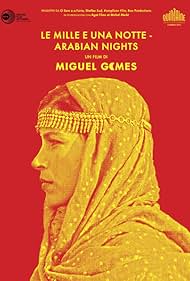VALUTAZIONE IMDb
6,9/10
2468
LA TUA VALUTAZIONE
Un'epopea adattata al Portogallo moderno che assomiglia alcuni episodi di Arabian Nights.Un'epopea adattata al Portogallo moderno che assomiglia alcuni episodi di Arabian Nights.Un'epopea adattata al Portogallo moderno che assomiglia alcuni episodi di Arabian Nights.
- Premi
- 16 vittorie e 23 candidature
Trama
Lo sapevi?
- ConnessioniFollowed by As Mil e Uma Noites - Volume 2: O Desolado (2015)
- Colonne sonoreDiferencas de Guardame las Vacas
Written and performed by José Miguel Moreno
Recensione in evidenza
The pressures of the social obligations from the recent Portuguese economic crisis in how to approach this loose adaptation of "One Thousand And One Nights" cut deep into director Miguel Gomes. He satisfied his anxiety by including his own personal struggle with a humorous twist in the first thirty minutes of his sprawling 6-hour Arabian Nights. Spliced between dual documentaries about a shipyard closure and wasp exterminators, Gomes – appearing on screen – literally evades his camera crew while they take chase. His nerves reflect the angst of the Portuguese people, but his eventual resolve in ultimately completing the film is a promising hint of hope, at least in a way to defy the government.
The opening of each volume of Arabian Nights – entitled "The Restless One", "The Desolate One" and "The Enchanted One" respectively – begin with a direct message from Gomes to establish what to expect, as well as to provide a pseudo-mission statement. It declares how this is not a direct adaptation despite drawing on the structure and the vignettes are based on events that happened between 2013 and 2014 where Portugal was 'held hostage' by its negligent government. The film always appears to have one step out of its fiction, but it's justified by its documentary prologue. The framing for the format, something that should be somewhat familiar to most, shows a Queen called Scheherazade who has to tell her King compelling stories and cut them off at night to ensure he wants to hear the rest of the story the next day to evade him killing her, and thus future Queens.
In adapting the spirit of the classic set of tales, it gives Gomes the freedom to explore different types of styles going from fantasy, to documentary, to fiction, to docu-fiction, and sometimes blending them together. As each story isn't firmly attached to a single protagonist, the film frequently has irreverent tangents with subplots briefly taking the foreground. While people may be on screen without an arc, it's a clear goal of the film to show how each individual has a rich full life with their own dramas that affect others too. It turns these modern day struggles into myths – and also shows how those myths are worthy enough to engage a hypothetical King. In employing non-actors, it continues to blur that line between fiction and nonfiction and makes Arabian Nights a film for the people while the subdued emotion of them soaks through.
Despite initially intended to be a single 6-hour feature, each of the three volumes are quite different in style and quality. The first volume is dense and absurd, both the most inaccessible and accessible part depending on how you feel about Gomes' approach. It's rewarding for those willing to traverse it. After introducing the values of the film with the opening documentary and the concept for its format in showing Scheherazade and her people coming up with the stories, the first vignette is the most bizarre and perhaps immature given the weight of the film. It travels with a group of impotent capitalists who are cursed with permanent erections and how that affects their attitudes to how they influence Portugal's financial. It's hilarious and thoughtful, showing just how on-the-nose but equally on-point Arabian Nights is willing to get. Volume 1's energy and unabashed direction earned a grin on my face whenever it wasn't documenting distress.
The following vignettes include one about a talking cockerel who's a controversial point in a town as he crows loudly in the early morning, though his intentions are to warn about wildfires, and another where a man disgruntled by the economy and arranges other unemployed people to join in a New Year's Day swim in the ocean as an act of defiance against the government. Each person tells their story – or their story is told by Scheherazade – and their hardships of their money going to waste are easy to empathise with, especially if you've experienced dejection such as they're facing. Like his masterful previous film Tabu – a diptych of sorts while Arabian Nights is a triptych within a triptych – this film also has an old-fashioned style. It has the rawness and vibrancy of the films of the 70s, though that aesthetic may not be as deliberate as Tabu's 1930s style.
See the other volumes for the rest of my review for Arabian Nights.
8/10
Read more @ The Awards Circuit (http://www.awardscircuit.com/)
The opening of each volume of Arabian Nights – entitled "The Restless One", "The Desolate One" and "The Enchanted One" respectively – begin with a direct message from Gomes to establish what to expect, as well as to provide a pseudo-mission statement. It declares how this is not a direct adaptation despite drawing on the structure and the vignettes are based on events that happened between 2013 and 2014 where Portugal was 'held hostage' by its negligent government. The film always appears to have one step out of its fiction, but it's justified by its documentary prologue. The framing for the format, something that should be somewhat familiar to most, shows a Queen called Scheherazade who has to tell her King compelling stories and cut them off at night to ensure he wants to hear the rest of the story the next day to evade him killing her, and thus future Queens.
In adapting the spirit of the classic set of tales, it gives Gomes the freedom to explore different types of styles going from fantasy, to documentary, to fiction, to docu-fiction, and sometimes blending them together. As each story isn't firmly attached to a single protagonist, the film frequently has irreverent tangents with subplots briefly taking the foreground. While people may be on screen without an arc, it's a clear goal of the film to show how each individual has a rich full life with their own dramas that affect others too. It turns these modern day struggles into myths – and also shows how those myths are worthy enough to engage a hypothetical King. In employing non-actors, it continues to blur that line between fiction and nonfiction and makes Arabian Nights a film for the people while the subdued emotion of them soaks through.
Despite initially intended to be a single 6-hour feature, each of the three volumes are quite different in style and quality. The first volume is dense and absurd, both the most inaccessible and accessible part depending on how you feel about Gomes' approach. It's rewarding for those willing to traverse it. After introducing the values of the film with the opening documentary and the concept for its format in showing Scheherazade and her people coming up with the stories, the first vignette is the most bizarre and perhaps immature given the weight of the film. It travels with a group of impotent capitalists who are cursed with permanent erections and how that affects their attitudes to how they influence Portugal's financial. It's hilarious and thoughtful, showing just how on-the-nose but equally on-point Arabian Nights is willing to get. Volume 1's energy and unabashed direction earned a grin on my face whenever it wasn't documenting distress.
The following vignettes include one about a talking cockerel who's a controversial point in a town as he crows loudly in the early morning, though his intentions are to warn about wildfires, and another where a man disgruntled by the economy and arranges other unemployed people to join in a New Year's Day swim in the ocean as an act of defiance against the government. Each person tells their story – or their story is told by Scheherazade – and their hardships of their money going to waste are easy to empathise with, especially if you've experienced dejection such as they're facing. Like his masterful previous film Tabu – a diptych of sorts while Arabian Nights is a triptych within a triptych – this film also has an old-fashioned style. It has the rawness and vibrancy of the films of the 70s, though that aesthetic may not be as deliberate as Tabu's 1930s style.
See the other volumes for the rest of my review for Arabian Nights.
8/10
Read more @ The Awards Circuit (http://www.awardscircuit.com/)
- Sergeant_Tibbs
- 16 ott 2015
- Permalink
I più visti
Accedi per valutare e creare un elenco di titoli salvati per ottenere consigli personalizzati
- How long is Arabian Nights: Volume 1 - The Restless One?Powered by Alexa
Dettagli
- Data di uscita
- Paesi di origine
- Siti ufficiali
- Lingue
- Celebre anche come
- Arabian Nights: Volume 1 - The Restless One
- Luoghi delle riprese
- Viana do Castelo, Minho, Portogallo(first part: shipyard)
- Aziende produttrici
- Vedi altri crediti dell’azienda su IMDbPro
Botteghino
- Lordo Stati Uniti e Canada
- 12.260 USD
- Lordo in tutto il mondo
- 28.245 USD
- Tempo di esecuzione2 ore 5 minuti
- Colore
- Proporzioni
- 2.35 : 1
Contribuisci a questa pagina
Suggerisci una modifica o aggiungi i contenuti mancanti

Divario superiore
By what name was As Mil e Uma Noites - Volume 1: O Inquieto (2015) officially released in India in English?
Rispondi





























